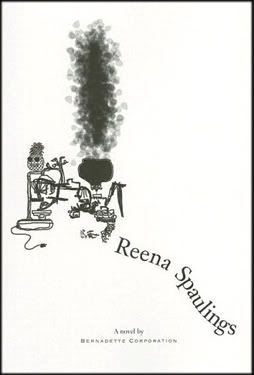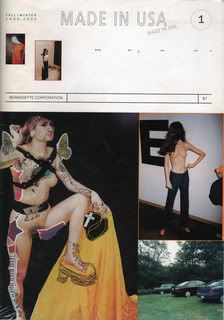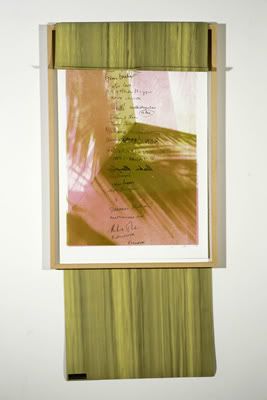Vive Le Corpse
It's been a busy week, occupied with lots of different bits of writing, but among all that I really enjoyed reading the novel Reena Spaulings by the art collective Bernadette Corporation.

[Images: The Belgian Marbles, Reena Spaulings. Presented at Sutton Lane in Brussles, 2009.]
For Reena Spaulings recent installation in the TATE café as part of the Pop Life exhibition, ‘her’ biog read:

It is the tale of the eponymous Reena’s journey through post 9/11 New York as a museum guard/hipster/waster/underwear model/minor celebrity/part time anarchist - and is recognisable in its wilful naivety as something we might easily compose ourselves; placing all our fantasies and most desired scenarios into a story in which we are the star.
In the introduction we learn that “This is a novel that could also have been a magazine,” and also that it was written Hollywood studio style, by 150 unnamed writers, so the sense of story and of the author are transparently set up as something fragmented and impossible to label or pin down to one specific person or identity. Immediately we enter into a space where what is presented as the ‘main’ character, the space for our focus as readers becomes slippery and easily losable amid other voices and gazes. What emerges is not so much a solid protagonist, but an amalgam of other people’s fantasies, desires, jealousies and aspirations. A body of rumours.
In the late 90’s Bernadette Corporation launched a magazine project called Made in USA, which was described as;
“Not a utopia, but a zone of productive ambivalence; underground fashion spreads, analyses of urban development trends, interviews with fashion designers and photographers, motivational speakers and the occasional artist of theorist, film reviews, idiosyncratic glossaries, man/woman on the street vignettes and advertisements for galleries and designers that consisted of nothing but their names on an empty page.”
This could be a description of the novel as every one of these “features” crops up in the book at one point or another. There are frequent allusions to product placement, fashion labels, bands, clubs and celebrity name drops - one chapter turns a chance encounter with Karl Lagerfeld into a full blown fashion fluff piece, another is composed entirely of press releases.
In employing this flighty vernacular BC are working both with and against the systems that now construct our history and culture for consumption. This is a collectively created heroine/artistic ideal - “an everyday group hallucination” as they put it in the novel. They attest that not only subject but artist is subject to this process of communal imagining...
In a text for Afterall entitled Be Corpse (Bernadette Corporation / B Corp / Be Corpse) they write:
“The ‘masses in mass production’ is a way of articulating the integration of bodies that produce their conditions as much as being produced by them. Understood as such, mass activity necessitates mass organising, embracing patterns of organisation that are difficult to avoid let alone be emancipated from. There is money to be made from the mass, and the mass in turn makes money. Everyone is part of the crowd, even if the collective agreement on what defines an individual promotes self-serving competition, striving to make it, and never waiting in line.”
This idea recalls something of a Warholian aesthetic, the notion of the sparkling, special allure of a vibrant cultural life but also a simultaneous awareness of its lucrative nature. The method of repackaging what we already know and have consumed in a fashion that makes us desire it more. The thrill of creating something but also being made to beg for it.
BC claims an arbitrariness in the choice of their name but I think the relationship between Corporation and corporeal is loaded and filters through the novel. The corpse or body as in the body of work, the body of society, which is one entity made up of many disparate parts.
This is most notable in the book through a spurious media company named Vive Le Corpse (which gets described in the book as a ‘blank signature’) which so many people are keen to be affiliated with despite the fact that its central nervous system seems to be in a constant state of meltdown. Here the idea of the body represents the collective as opposed to the individual - a bricolaged assembly of the real or recognisable.
Bernadette Corporation continues to feed back into the desires of a mass or community consuming as tastes evolve. After the novel was published, Reena Spaulings became a gallery in New York (a gallery that represented Bernadette Corporation in fact) and prompted many requests for the business and curatorial services of the fictional collector. These activities have evolved and several artists now make work under the name Reena Spaulings, who is independently represented by galleries in London, Paris and New York.
The work carries across a DIY aesthetic, full of banners to nothing and no one, as well as a lionising of the mundane through the vector of art/history. The supposed relics of a careful culture are in fact surfboards and beachscapes…
[Images: The Belgian Marbles, Reena Spaulings. Presented at Sutton Lane in Brussles, 2009.]
For Reena Spaulings recent installation in the TATE café as part of the Pop Life exhibition, ‘her’ biog read:
[She] is also a fiction, appearing, for example, as the main character in the 2004 novel Reena Spaulings, by Bernadette Corporation, a group of artists and writers formed in the mid-1990s.
So now this idea or entity or artistic self has become totally revised and re packaged amid mythologies and hard to trace snippets of facts which serve to re order and re write history according to what we, the crowd, most desire to believe. We become both creators and consumers of this epic scattering of the real/ideal - implicated in this act of disappearance by the artists.






Comments